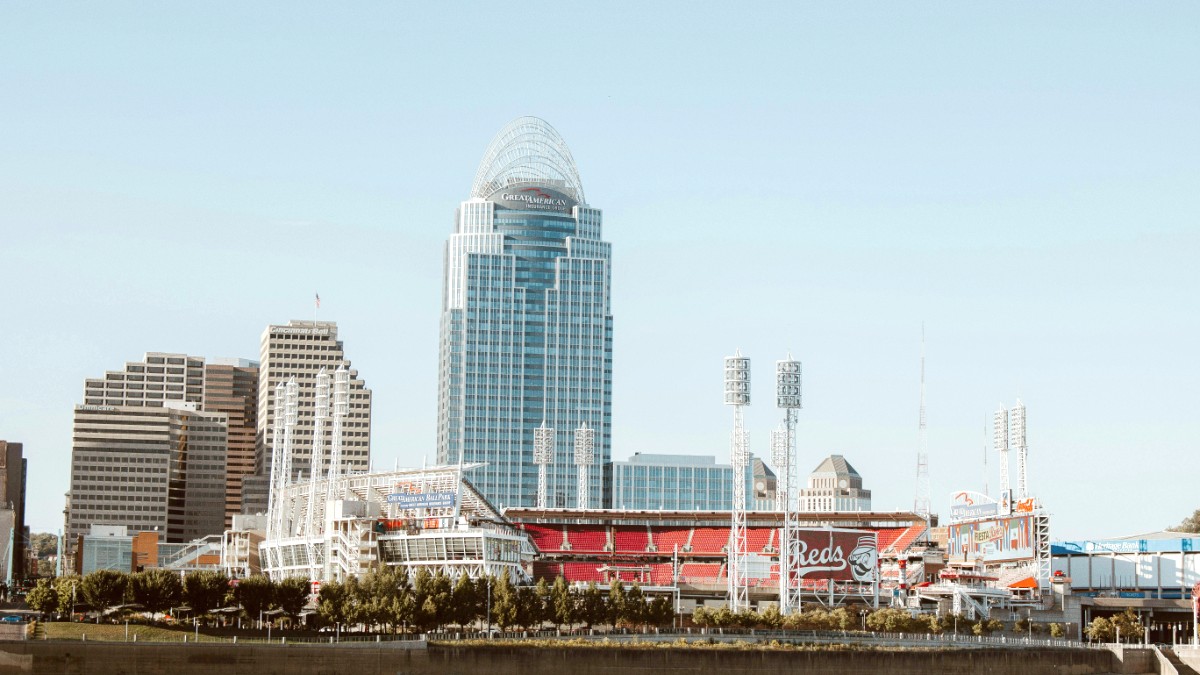
Great Lakes, USA
The Ohio River historically served as a major transportation route, connecting the city to the Mississippi River and beyond. This early access to markets and resources allowed Cincinnati to become a flourishing river port and commercial center during the 19th century. Cincinnati's topography distinguishes it from many flat Midwestern places. The city sits on what some call "seven hills," referring to its undulating landscape. These hills present natural viewing spots, with sweeping views of the downtown skyline and the winding Ohio River.
Cincinnati is a distinct position in the American Midwest, anchored in the southwestern corner of Ohio. The city extends along the northern bank of the Ohio River, a waterway serving as the state line between Ohio and Kentucky. Directly across the river, Northern Kentucky cities like Covington and Newport expand the metropolitan area, forming a continuous urban landscape connected by bridges.
Neighborhoods like Mount Adams and Clifton perch atop these hills, offering elevated perspectives and a specific sense of place. The immediate area moves from a relatively flat river plain, where the downtown core and the riverfront parks sit, to steeply rising terrain just a few blocks inland. This varied topography influences street layouts, park locations, and residential areas, contributing to the city's visual appeal and diverse character.
Cincinnati's narrative begins in 1788, making it an early major American city established after the Revolutionary War. Its beginnings as a frontier settlement quickly became rapid expansion, fueled by its strategic location on the Ohio River. By the mid-19th century, Cincinnati became a busy river port and an industrial force. This period earned it the lasting nickname, "Queen City," a reflection of its elegance, prosperity, and status as a Western city before the prominence of Chicago and St. Louis. The city's significant role in pork processing also led to the less elegant but equally descriptive nickname, "Porkopolis," emphasizing its agricultural and manufacturing might. Millions of hogs were processed here, leading to innovations in meatpacking and cold storage that shaped the nation.
Directly across the Ohio River from the slave state of Kentucky, Cincinnati became a link on the Underground Railroad. This network of secret routes and safe houses gave freedom to enslaved people moving North. Brave individuals and communities in Cincinnati risked their lives to offer refuge and support, embodying a spirit of liberty. The National Underground Railroad Freedom Center, located on the city's riverfront, is a powerful testament to this history, offering visitors a deep, moving journey into stories of courage and resilience. This past continues to define Cincinnati's identity as a place of progress and human rights.
One of the earliest post-Revolutionary War cities.
Mid-19th century, a period of industrial and commercial strength.
A major center for pork processing, influencing national industries.
A important crossing point to freedom for enslaved people.
Home to the first openly professional baseball team, the Cincinnati Red Stockings (1869).
German settlers, seeking new opportunities and escaping political unrest, came to the city, especially to the neighborhood north of downtown, known as "Over-the-Rhine." Their cultural contribution remains evident in the city's architecture, its brewing tradition (Cincinnati was a pre-Prohibition beer capital), and its distinct culinary landscape, including the famous Cincinnati chili and goetta. The preservation of this historic district, now a lively area of restaurants, breweries, and boutiques, invites appreciation of this heritage.
This neighborhood reflects significant German influence in Cincinnati's architecture and cultural development. It is now a lively area with preserved historic buildings, offering a look into the city's immigrant past.
Cincinnati is a special place in American sports history as the beginning of professional baseball. The Cincinnati Red Stockings, formed in 1869, were the first openly professional baseball team, forever connecting the city to the nation's pastime. Today, the Cincinnati Reds continue this legacy at Great American Ball Park.
Cincinnati's history, from its industrial innovations and role in the fight for freedom to its rich immigrant heritage and sporting firsts, presents a narrative that underpins its present-day character.
Cincinnati, the "Queen City," displays a dynamic urban experience within its Midwestern setting. The city proper, as of 2023 estimates, comprises about 309,000 residents, forming the core of a much larger metropolitan area spanning over 2.2 million people across parts of Ohio, Kentucky, and Indiana. This larger population base speaks to Cincinnati's reach as a regional center for commerce, culture, and community.
Cincinnati's cultural landscape shines, with a wide array of artistic and historical experiences. The city presents a strong arts scene, with institutions like the Cincinnati Art Museum, housing an expansive collection spanning millennia. Music Hall, a National Historic Landmark, presents a grand venue for performances by the Cincinnati Symphony Orchestra and Cincinnati Ballet. The Cincinnati Playhouse in the Park, a Tony Award-winning regional theater, consistently stages high-quality productions. Its streets feature Italianate architecture, art galleries, independent boutiques, and a lively dining and craft brewing scene. This blend of established institutions and energetic new developments shapes a dynamic cultural fabric.
sectors include healthcare, manufacturing, finance, education, and growing technology.
Home to global headquarters for Procter & Gamble and Kroger, and Fifth Third Bank.
Observes Eastern Time (ET), including Eastern Daylight Time (EDT) in warmer months.
The city boasts a strong arts scene, with institutions like the Cincinnati Art Museum and Music Hall. The Cincinnati Playhouse in the Park, a Tony Award-winning regional theater, stages high-quality productions. This array of cultural venues enriches the city's experience.